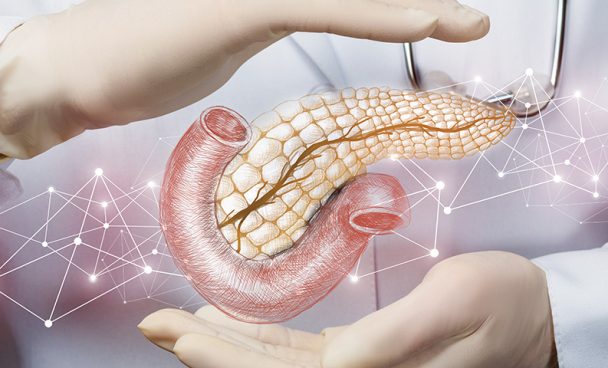What is pancreatic cancer
The pancreas is the organ responsible for releasing enzymes that act in the digestion process and for producing hormones that help keep blood sugar under control. It consists of three parts: the head (right side), the body (center) and the tail (left side). The most common type of pancreatic cancer is adenocarcinoma, corresponding to 90% of diagnosed cases, most of them located in the region of the head of the organ.
According to the International Union for Cancer Control (UICC), cases of pancreatic cancer increase with advancing age: from 10/100,000 population between 40 and 50 years old to 116/100,000 population between 80 and 85 years old. In Brazil, it is responsible for about 2% of all types of cancer diagnosed and for 4% of the total deaths caused by the disease.
Some risk factors contribute to the development of pancreatic cancer. Some of them are modifiable through treatment and lifestyle changes. Are they:
- Smoking;
- Overweight or obesity;
- Diabetes;
- Chronic pancreatitis; and
- Occupational exposure to certain chemical agents.
Non-modifiable risk factors include:
- Age;
- Male;
- Afro-descendant;
- Family history;
- Hereditary genetic syndromes (hereditary syndrome for breast and ovarian cancer caused by mutations in the BRCA1 or BRCA2 gene; hereditary breast cancer; familial atypical multipolar melanoma syndrome (FAMMM); hereditary pancreatitis; Lynch syndrome; and Peutz-Jeghers syndrome ); and
- Chronic pancreatitis triggered by genetic alteration.
Symptoms and signs of pancreatic cancer
Pancreatic cancer does not usually cause signs or symptoms at a very early stage – they usually occur when the tumor is already large or when the cancer has spread to other parts of the body. It is important to be aware of some signs and symptoms, such as
- Weakness;
- Weight loss;
- Lack of appetite;
- Abdominal pain;
- Back pain;
- Dark urine;
- Jaundice (yellow colored eyes and skin);
- Nausea;
- Back pains;
- Deep vein thrombosis (identification of a blood clot, usually in a major vein, such as in the leg);
- New-onset diabetes; and
- Abrupt worsening of an already old diabetes.
While these symptoms are not unique to pancreatic cancer, they can offer clues to the doctor. It is also important to be alert to diabetes, which can be both a risk factor for pancreatic cancer and a clinical manifestation that precedes its discovery. Some studies indicate that in 74% to 88% of individuals with pancreatic cancer and diabetes, the diagnosis of diabetes occurs within a window of 24 months before the identification of the neoplasm.
Pancreatic cancer diagnosis
The diagnosis of pancreatic cancer rarely happens in its early stages, when the chances of cure are greatest. This leads to the discovery of a more aggressive cancer, with a high mortality rate.
The first diagnostic step is to perform a physical examination and collect data on the patient’s personal and family history. Some of this information can offer important clues to the doctor.
In the next phase, the individual undergoes additional tests, such as:
- Laboratory tests (blood tests that evaluate liver function or tumor markers, such as CA 19-9 or carcinoembryonic antigen – CEA);
- Imaging tests (such as CT, MRI and PET Scan, which allow you to visualize the tumor, its extent and whether it has spread to other parts of the body);
- Cholangiopancreatography (evaluates whether the bile and pancreatic ducts are blocked, narrowed, or dilated);
- Angiography (specific imaging exam for the visualization of blood vessels);
- Biopsy (can be done percutaneously, where the doctor inserts a thin needle through the abdomen and removes a small sample of the tumor; endoscopic, where the sample is taken during an endoscopy exam; guided by a CT scan; or surgically).
Treatment
Once the diagnosis is made and the type of tumor and the stage the cancer is in (tumor staging) are defined, the specialist doctor and his multidisciplinary team draw up a treatment plan.
Surgery is the only approach that offers a curative chance. However, it is an option only in a minority of cases, since most of the time the diagnosis is made when the disease is in an advanced stage.
Other forms of treatment include radiotherapy and chemotherapy, which can be done alone or in combination, to shrink the tumor and/or eliminate cancer cells that may be left over after surgery.
When pancreatic cancer is at a very advanced stage, the probability of cure with these treatments is very low. In this case, the objective becomes patient comfort and symptom relief through palliative care.
Prevention
You can reduce your risk of developing pancreatic cancer by:
- Quit smoking;
- Maintain a healthy weight;
- Adopt healthy lifestyle habits that include a balanced diet, rich in vegetables, fruits and whole grains, in addition to reducing the size of the ingested portions;
- Practice physical activities regularly; and
- Avoid consumption of alcoholic beverages.
